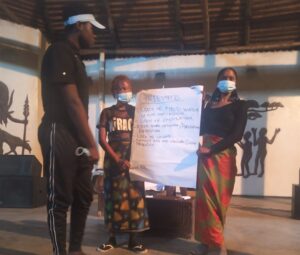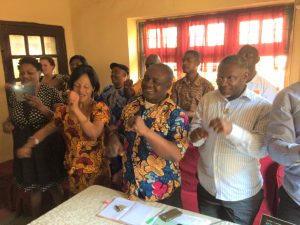Minds of the Movement
An ICNC blog on the people and power of civil resistance
by Mariam AzeemMarch 02, 2022
In my first post, I followed up on Hardy Merriman’s insights for activists who don’t know where to start when it comes to movement training. In my work, this is the million-dollar question! Figuring out the first steps toward capacity building is often a huge obstacle for movements.
In this second post, I expand on Merriman’s insights about how to obtain funding for trainings. My informants—movement coaches who have completed Rhize’s Global Coaching Fellowship and who are based in Uganda, Nigeria, Zambia, and Malawi—also take us back to square one and trace the ideal path from grievance to funding to capacity building.
How do we find funding for training?
There are several approaches and tips for finding training funds. To summarize:
- Networking (approach #1)
- Proposal writing (approach #2)
- Fundraising activities (e.g Fundraising events, walks, selling merchandise) (approach #3)
- Diversify funding sources (tip #1)
- Creating relevant and sustainable programs that attract funds and produce tangible deliverables that serve the movement’s greater vision (tip #2)
- Contacting multiple donors (tip #3)
- Generating in-kind resources (tip #4)

Ndola, Zambia, New Masala theater group training with coach Angela Nglube.
Some activists receive funding through networks and organizations with which they are affiliated. It’s actually a good idea in general for movement members to have affiliations, whether you are seeking funding or not. Your affiliation can increase your awareness of other groups’ activities and also how to overcome common challenges of obtaining funding.
Another approach is to apply for funding in response to calls for funding proposals. This requires a certain level of access to digital technologies and the internet. Along this vein, you can use online donors databases (for example, find this and more on the Human Rights Funders Network website) to search for funding opportunities to which you can apply. A more grassroots approach to resource mobilization would be to create a donation link (GoFundMe, for example) and share it via a “Donate” call-to-action button on your website and social media channels.
If your internet access is limited, there is nothing stopping you from approaching local companies with similar interests. Ask them in person or write to them for support, and make sure you have a clear message and “ask”. Individual contributions from local well-wishers can go a long way, as they have the added benefit of always coming from within the community and not from foreign actors.
Joining a consortium or network is also applicable advice for fundraising for a training. It is easier to get funding when other organizations can recommend your work. Sometimes networks apply for funding as a group and then allocate to small groups that are part of those networks.
To cut costs and/or use funds more wisely, a movement can mobilize activists to utilize their individual skills in service of the movement. For example, if one activist works at a restaurant, s/he could approach the restaurant owner for permission to serve food that is leftover from a shift at a march or protest, instead of it being thrown away that day. Similarly, activists can seek to individually develop access, connections and skills that could doubly serve the movement (an activist training to become a chef or taking a job at a restaurant, both of which could provide a connection for making meals or serving leftover food to protesters). Other common skills that are handy for a movement to have on their team include writing and editing, to help with proposal writing.
A movement can also seek in-kind contributions, such as free training space from religious institutions, universities or libraries.
In the same vein, cost-cutting measures include finding public spaces that can be reserved for free; holding trainings virtually to save costs; and considering scheduling shorter trainings than originally planned.
What are common challenges or obstacles with funding a training?

Nonviolent action training in Cameroon, 2016. Photo courtesy of Amber French.
In some areas of the world, activists encounter significant obstacles to obtaining funding for training. They are out-of-reach of significant assets, such as well-connected activists with several movement and funder affiliations. In remote areas and/or in the presence of severe government surveillance, it can also be a challenge to register a group that works on social justice. Most official organizations that provide funding rely on very formal channels, which involve registering entities in the country. This is difficult for activists because it puts them at risk of arrest, blocked bank accounts, withheld funds, and surveillance, thereby posing a threat to their movement or group.
One way movements have overcome these obstacles is by establishing personal, trusted networks, which are not easily monitored by the state. This implies careful planning, trust building, and deep knowledge of online and offline security procedures. Some groups also pool small personal savings together to obtain minimum capacity building, then build from there.
From grievance to operational movement
One movement coach I interviewed was very helpful and traced the ideal path from grievance to funding to capacity building. Although many readers will already be in the thick of organizing and fundraising, I thought it would still be helpful to share this model as a way to ground our thinking around movement capacity building.
In a perfect world, a group would navigate the following steps:
- Make a grievance known in your community to help form a critical mass of participants (this can be as few as 5 or 10 people). Take necessary security measures. Consider reaching out to a media organization interested in amplifying local voices and ask for media outreach support. It is not too early to begin local fundraising as part of this initial step: A movement has to mobilize around grievances to build both numbers and resources.
- Recruit participants for specific skills that would be useful for your movement, as well as at least one or two experienced and well-connected activists, if possible (see my first post).
- Conduct an assessment to determine the group’s training needs (see my first post).
- (Continue to/expand efforts to) Fundraise or apply for funding for a training (see above).
- Organize planning meetings with the aim to anticipate future training needs to stay one step ahead of the movement cycle (through monitoring and evaluation). For example, if street actions are being organized, it may already be time to start fundraising and recruiting a trainer for a nonviolent discipline training. To whatever extent possible, hold such planning meetings on a regular basis.
- In parallel with the previous step, launch networking and outreach efforts to identify available trainers.
- Form internal sub-committees for settling grievances and other disciplinary matters. It’s never too early to do this. Group unity is a crucial yet often overlooked step toward capacity-building. How can a group take a step forward toward capacity-building when it is weighed down by disputes and internal division?
Of course, in the real world, groups have little time to implement every single step that my informants and I have suggested in this post. But activists can use the above checklist to at least get a general sense of where their group is in their journey toward capacity building. It can sometimes be a rough path, but I have personally been in touch with dozens of movements around the world who successfully completed this long and beautiful journey.

Mariam Azeem
Mariam Azeem possesses nearly fifteen years of experience and expertise in the field of education, training, and coaching for nonviolent civil resistance, human rights, women’s leadership, and movement building. She supports and facilitates youth, women, and gender and sexual minorities in advancing their narratives of human rights and justice.
Read More